Dehydration is a health condition in which a body loses more fluids than it intakes. Dehydration in dogs is similar to humans and it is a common health emergency. Dehydration for dogs is the incapability to replace lost fluids, orally.
Like all nutrients such as vitamins, minerals, protein, and fat. water is also very important for your dog’s health. Dehydration in dogs occurs when the dog doesn’t drink enough water.
If less water intake causes dehydration in dogs at the same time excess water intake could be a sign of an underlying disease. You should keep a watch on your dog’s water intake to look for less or excess intake.
Dehydration in dogs is a very common problem in dogs. There are many reasons that cause dehydration in a dog. Below are the basics and important points of dehydration in dog. Continue reading to know what to do when your dog is dehydrated.
What is
Dehydration in Dogs?
igure class="wp-block-image">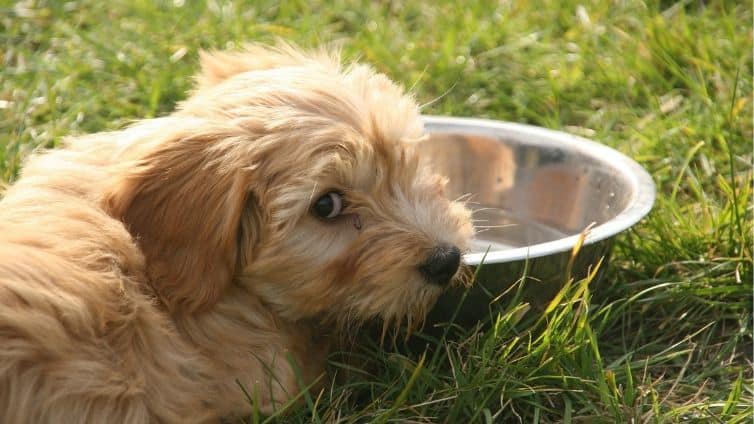
When a dog’s body starts losing more fluid than the number of fluids it takes in this condition is termed as dehydration in dogs. A dog’s body starts to draw fluids out of cells when the water level is too low in their bodies.
If your dog is suffering from dehydration then in this process his body will lose many electrolytes namely, calcium, sodium, potassium, and magnesium. Electrolytes are very important for the normal functioning of all the cells in the body.
An imbalance in this normal functioning of electrolytes can interrupt the smooth function of other body organs and systems. If the conditions worsen, dehydration in dogs can cause organ failure and become fatal.
Dehydration in a dog also depends on his size, age and health. Puppies and older dogs are at a higher risk to suffer from dehydration than middle-aged or adult dogs.
If you own a Poodle or a Chihuahua, your pooch is likely to lose water faster because they have smaller bodies. In some dogs, dehydration is quickly fixable by a clean bowl of drinking water while others require consistent care and efforts.
A canine’s body loses water naturally, all day. Even though your dog’s body losing water by any means is not visible to you but they do lose their natural fluid build-up. There are many causes of dehydration in dogs.
What >What Causes Dehydration in Dogs?
ass="wp-block-image">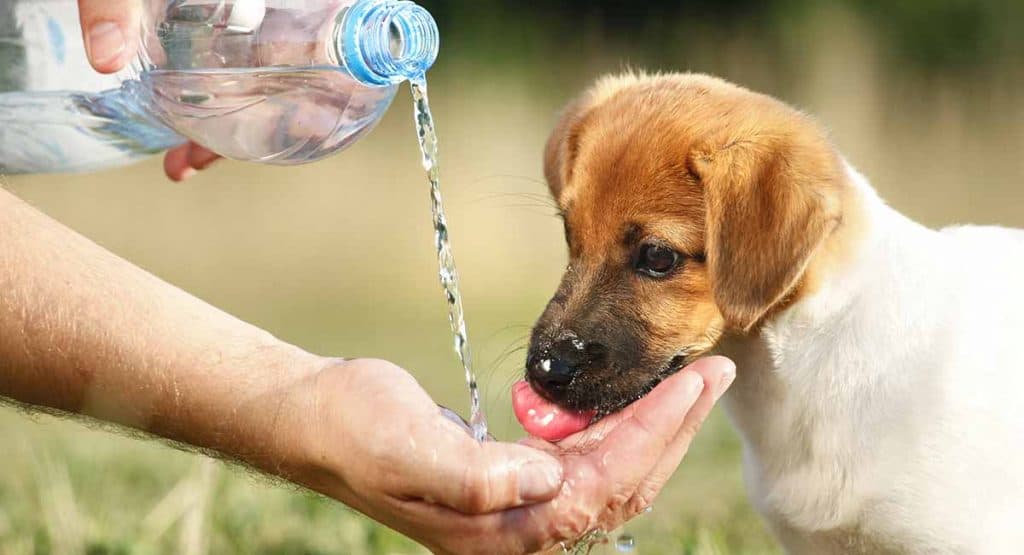
Dehydration in dogs is a risk for all dogs that do not drink enough water. Drinking less water is the primary cause of dehydration for dogs. However, loess water intake is not the only case.
There different other reasons which cause dehydration in dogs. Your dog can be dehydrated as a result of some sickness. Dogs that are sick also experience dehydration because that sickness can cause the body to lose more fluids.
If your dog is sick he/she won’t just lose water but his/her body loses essential electrolytes as well. In such cases, your dog might refuse to drink water. Reasons for dehydration in dogs other than less water intake are:
- An underlying sickness or severe health issues such as high fever or even a heart stroke.
- Nausea
- Lethargy and inactive behavior in dogs.
- Pain
- Excessive vomiting or diarrhea also causes loss of fluids.
- Frequent urination and urinating in higher volumes than what is considered normal. Frequent urination can be a result of kidney stones in dogs or diabetes.
Making dogs drink enough water to treat the dehydration is not an insufficient solution to compensate for the loss of fluids. If your dog is suffering from any of the above condition you must consult a vet and check if the above problems are causing dehydration.
Dehydration in dogs is also caused by sweating in dogs. Dogs do not sweat a lot but they do sweat from their nose and footpads. Dogs also lose fluids when they are panting as they are actually eliminating their body heat.
This is mainly because while panting they lose lot of water by means of evaporation. Dogs also lose body fluids by peeing and pooping. These natural ways let out enough content of water and this is why they need to drink enough water.
Signs o>Signs of Dehydration in Dogs
s="wp-block-image">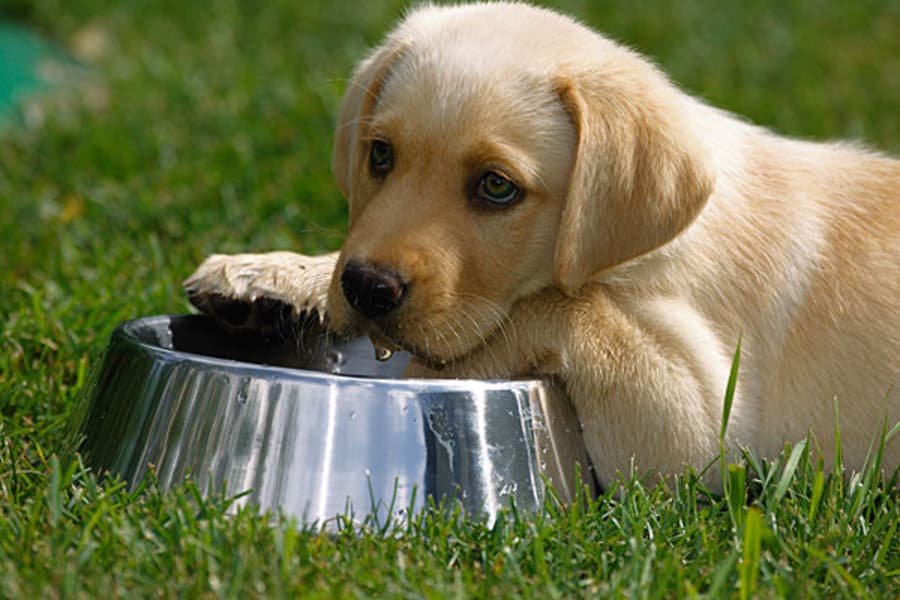
Any sickness or an underlying health issue has its particular signs and symptoms. Symptoms of any sickness are usually all the same as lethargy, pain, lack of appetite, weakness etc. and so are the signs of dehydration in dogs.
If you suspect your dog to be dehydrated you should look out for the early symptoms and keep a close eye on his/her behavior. Dehydration results in symptoms that range from mild to severe. Some of the warning signs of dehydration in dogs are:
1. Panting
As mentioned above that panting causes dogs to lose a lot of fluids and they eliminate heat through panting and lose water through that evaporation. In hot weather you tend to easily dismiss your dog’s heavy panting.
During this time your dog is losing many fluids via panting because panting is a way for them to cool themselves of the excess heat. The heavy panting is a way dogs for expressing thirst. However, heavy panting is a warning sign for humans to check dehydration in dogs.
2. Lethargy
With all the heavy panting and loss of water, your dog will start to feel more and more thirsty. This feeling of thirst will start wearing your dog down. This further makes the dog more inactive and lethargic.
You may notice your dog to sleep a lot and not engage in events that require too much physical activity. Dehydration in dogs causes lethargy and at this stage, other signs of dehydration will also start to show up.
3. Loss of appetite
Inactivity or lethargy will lead to a loss of appetite in your dog. When dogs are inactive they either tend to lose appetite or overeat. When your dog is experiencing dehydration he/she will also experience a loss of appetite.
Loss of appetite is easy to detect as your pooch will start leaving its meal untouched, even his favorite food stuffs. Like all other animals, dogs need a lot of water than food and dehydration for dogs is just the susceptible reason for dogs to avoid eating food.
4. Yellow-orange urine
Apart from all the external signs of dehydration in dogs, there are also internal symptoms like the changed color of urine that points out dehydration. If your dog is dehydrated that will affect their urine to change its color.
A strong yellowish or orange color of the urine is a sign of dehydration. Dogs also pee less when they are dehydrated, so except that as well. In situations like these you should make sure your dog is drinking enough water.
Give them a clean bowl to drink water and check on them more often. If you find the drinking bowl to be untouched, it is your warning sign to get your dog checked for an underlying health issue.
5. Dry and sunken eyes
Yet another externally visible sign of dehydration is dry, sunken or swollen eyes in dogs. A well-hydrated dog has shiny and alert eyes. When dehydrated your dog might lose that shine and spark in his eyes.
You can easily make out a dog’s health condition by their eyes which reflect their overall mood and behavior.
Besides the above severe symptoms, there are other symptoms of dehydration in dogs such as:
- Loss of skin elasticity
- Weakness
- Loss of balance
- Loss of skin elasticity
- Fast breathing
- Weak pulse
- Shock
- Collapse
- Dry gums
- Vomiting or Diarrhea
Testing Deh>Testing Dehydration in Dogs
p-block-image">
Now that you know the causes and symptoms of dehydration in dogs you should also know how to test your dog for dehydration. The signs are not enough to conclude that your dog is dehydrated.
To be very sure you have to check your dog for dehydration. The best way to check your dog for dehydration is to use your thumb and forefinger and pinch the skin on your dog’s back or the top of his head.
A well-hydrated dog’s skin will spring back well and fine when you release their skin. If there is a loss of moisture the skin will take quite some time to move back into place.
When there is severe dehydration in dogs, the pinched skin does not spring back at all. This skin elasticity test is the easiest way to determine dehydration in your dog.
The reduced elasticity of a dog’s skin is termed as ‘Skin Tent’. Obese dogs also have reduced elasticity of the skin and can have mild skin tent. This doesn’t necessarily mean that the dog is dehydrated. You can know more about obesity in dogs.
In older dogs with ageing skin it is difficult to assess the skin elasticity as their skins are already wrinkly. The same is with dog breeds that have a thick coat or dogs which have skin folds.
Treatment for Dehydrati>Treatment for Dehydration in Dogs
e">
If you suspect dehydration in your dog the veterinarian will not tell you otherwise. Your vet will also carry out a full body examination of your dog. The veterinarians do so to check the severity of dehydration in dogs.
The correct time to visit a vet should be early when you feel something is wrong with your dog. Your vet will recommend a blood test, x-rays, or even ultrasound scans.
The severity of dehydration in dogs is easily clarified by a blood test. The blood test then helps to determine the cause and required treatment for the dog. Your vet will put your dog on intravenous fluids supply to help replace the lost fluids. The best way to treat dehydration in dogs is to place your dog on drip.
The purpose of an external supply of fluids is to correct the imbalance of essential electrolytes. Your vet may also suggest an oral electrolyte solution for your dog. External electrolyte supplement like HydrADE help dogs in maintaining a balance in the electrolyte levels.
How to Rehydrate a Dog<>How to Rehydrate a Dog
e">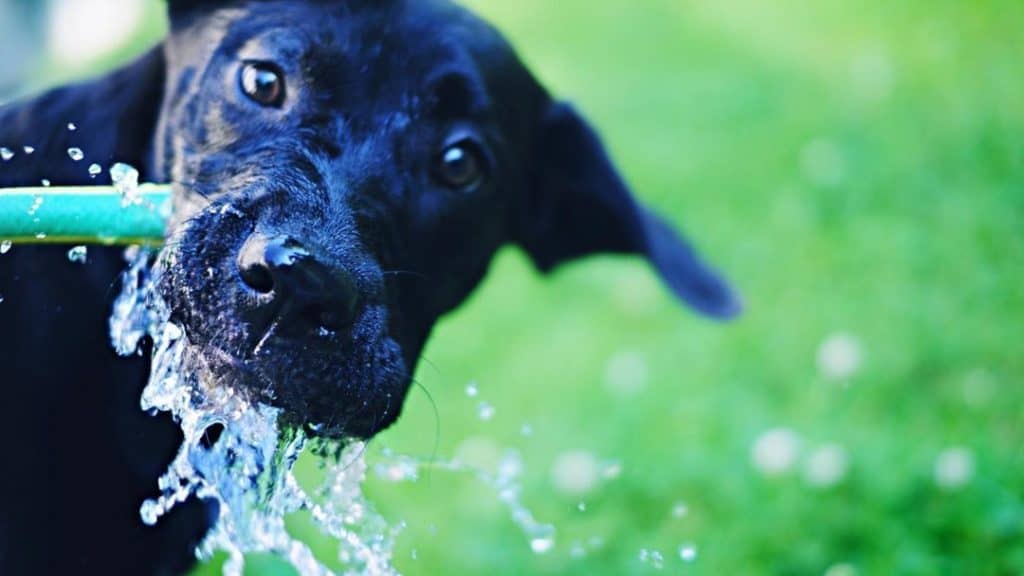
A healthy will never show any of the above symptoms. Dogs have the tendency of panting and they may pee yellow once in a while. This does not necessarily mean the dog is dehydrated.
However, when dehydration in dogs does occur rehydrating your pup is a must. To rehydrate a dog make sure your dog drinks enough water. When the intervention of a vet is required intravenous fluid and electrolyte supplements are an added requirement.
To rehydrate your sick dog feed him/her chicken or beef broth. Feeding them chicken broth is the best option when your dog doesn’t drink enough water. The chicken broth is tasty and also balances the fluid levels.
You can also give your dog icy treats. Popsicles or icy treats are helpful to cool off the heat and rehydrate your buddy. You can use fruit based icy treats or whole fruits such as watermelons to rehydrate your dog.
Dehydration in dogs also requires giving them enough water to rehydrate themselves. One ounce of water for each pound your dog weighs is the best way to keep them hydrated or rehydrate a dog.
Handy Tips For <>Handy Tips For Preventing Dehydration in Dogs
>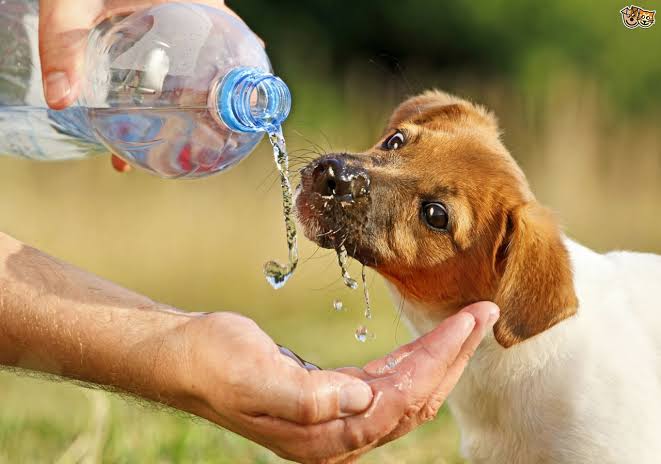
To prevent dehydration n dogs you need to follow some basic rules:
- Make sure your dog has enough fresh and clean water to drink and also the water is easily accessible.
- Check the water bowl every hour to see if your dog isn’t avoiding drinking the water.
- Clean the water bowl daily to prevent the accumulation of bacteria.
- When taking your dog for a walk or when traveling with your dog, carry enough fresh water for the dog to drink and stay hydrated.
- Avoid exercising for dogs in hot weather and keep in indoors or in cool and airy spaces.
- Be careful and void leaving your dog in a car for longer periods.
Dogs need water more than food and keeping them hydrated is the responsibility of dog owners. Dogs lose a lot of fluids naturally and to replace the loss they need a proper intake of water. Keeping your dog hydrated should never be avoided. Dehydration in dogs can lead to dire consequences and sometimes even result in death.
Hello Readers,
We hope this article will help you in keeping your dog hydrated and hope we made sure that why you always need to keep water bowls filled and clean for your dogs.
Let us know your views about dehydration in dogs in the comment section below.
Happy Petting to you Guys!












